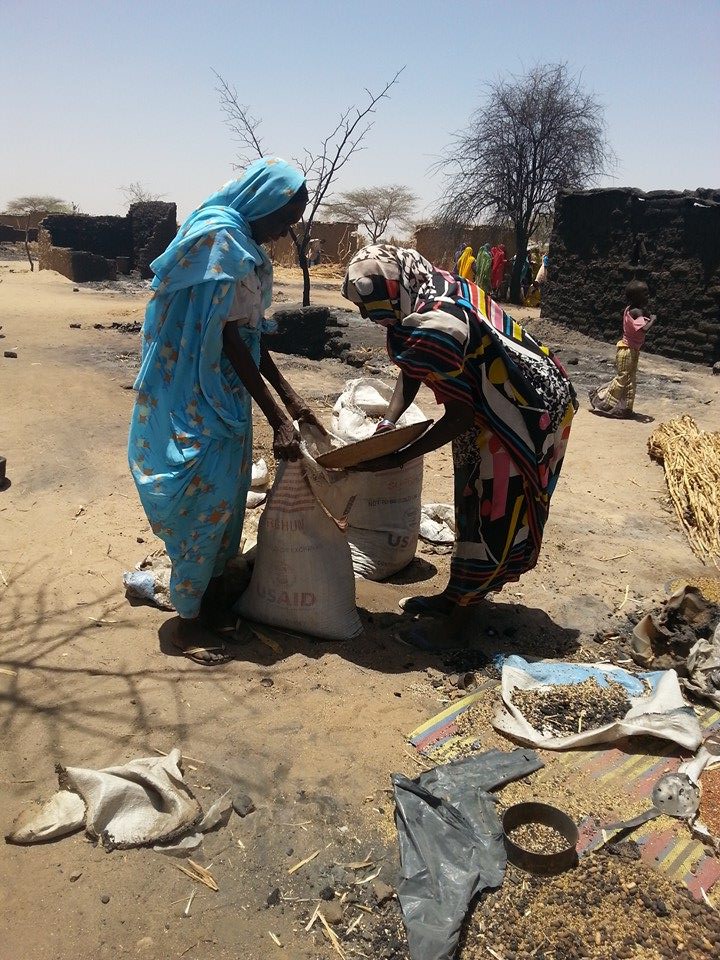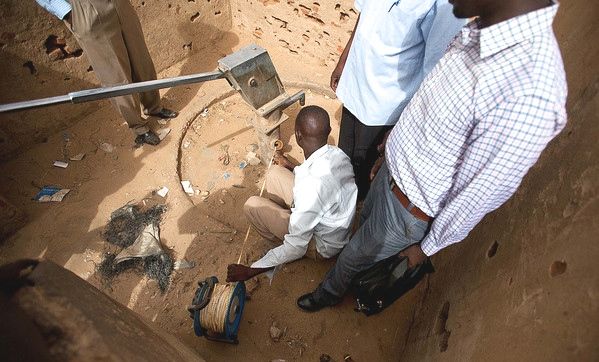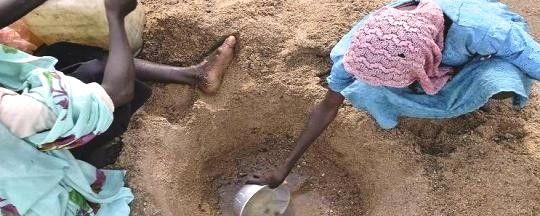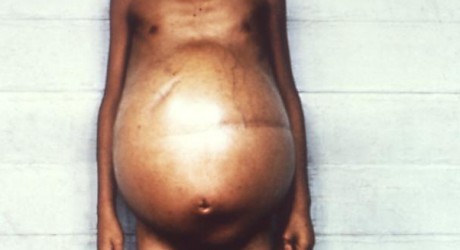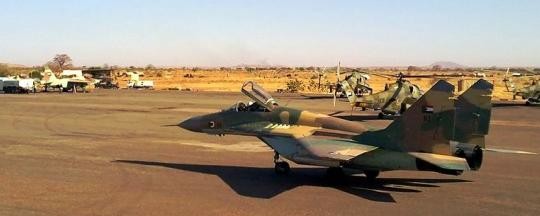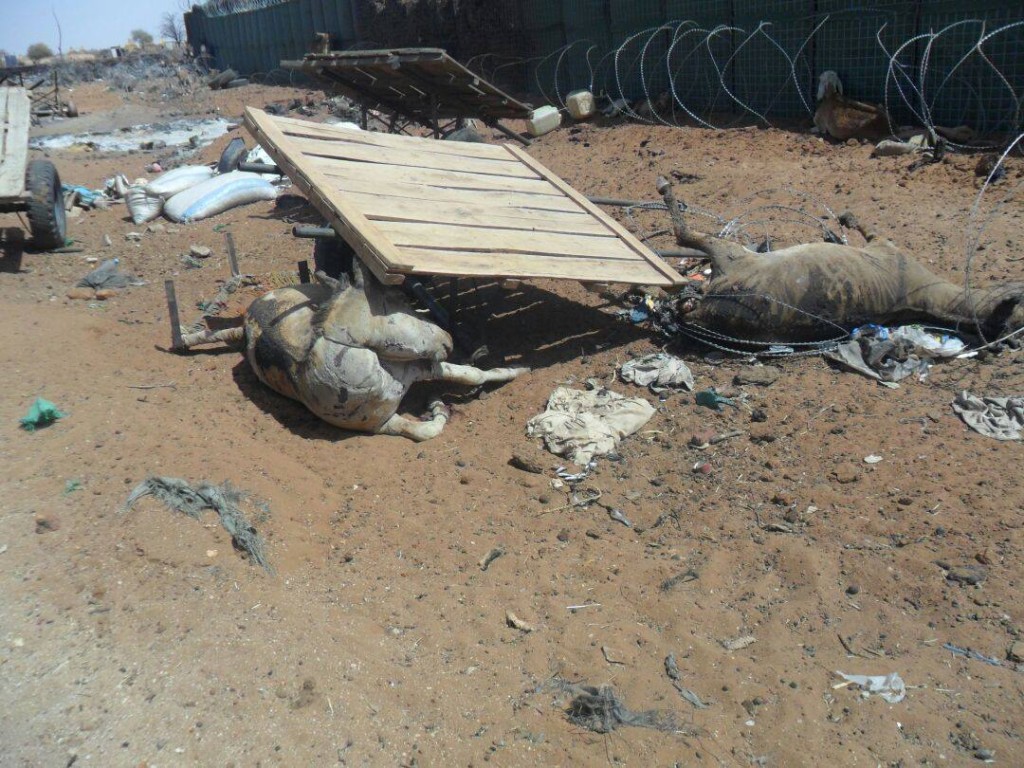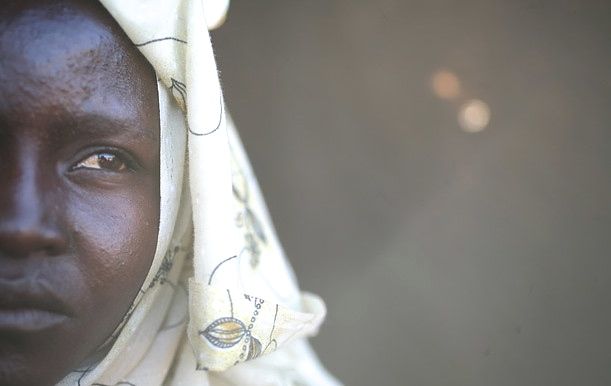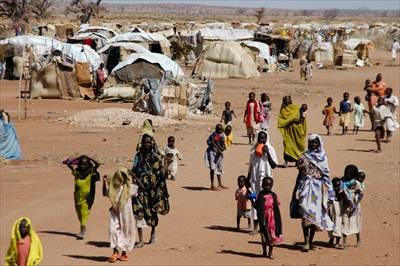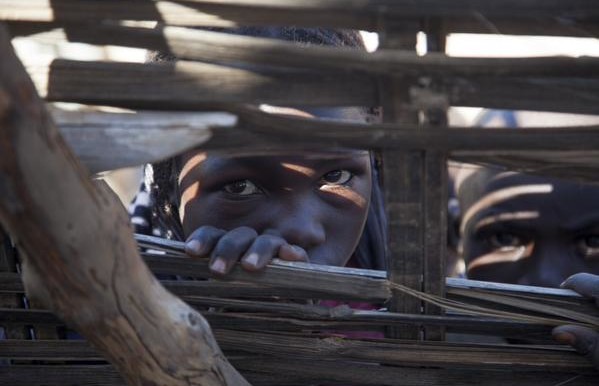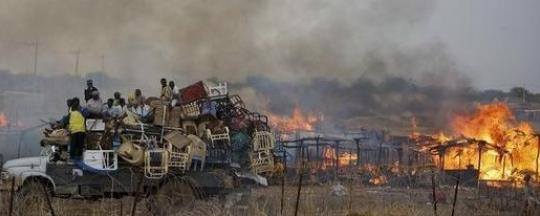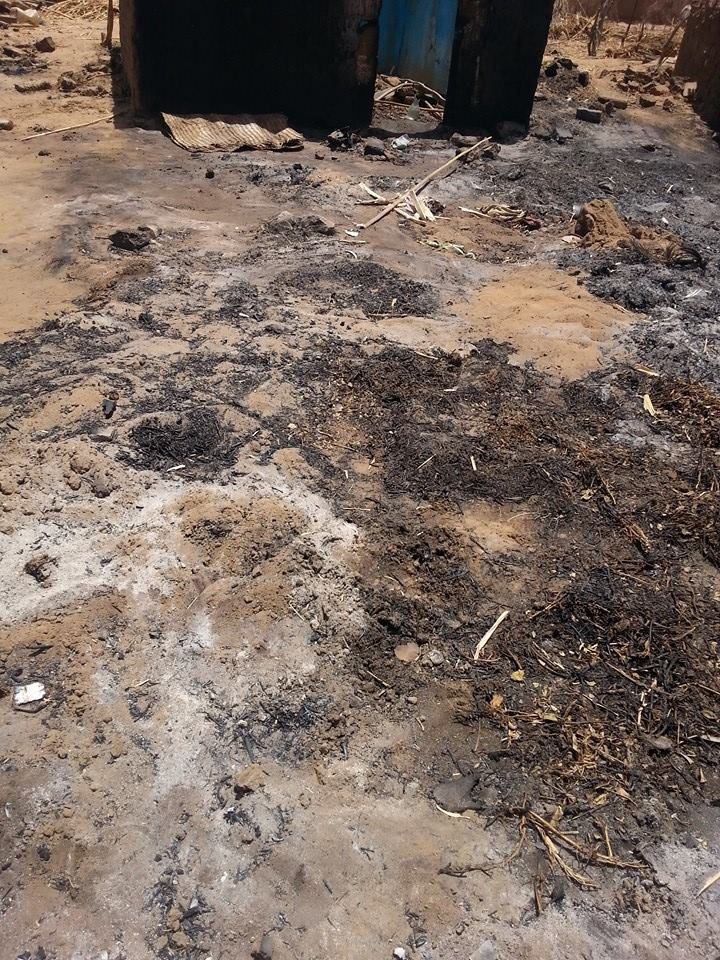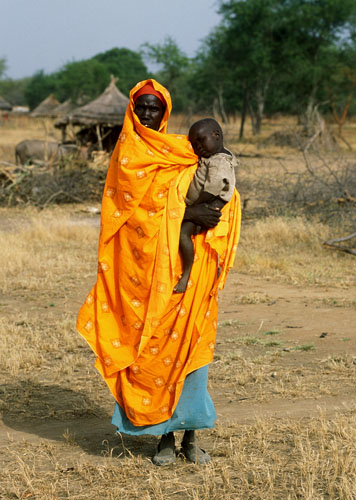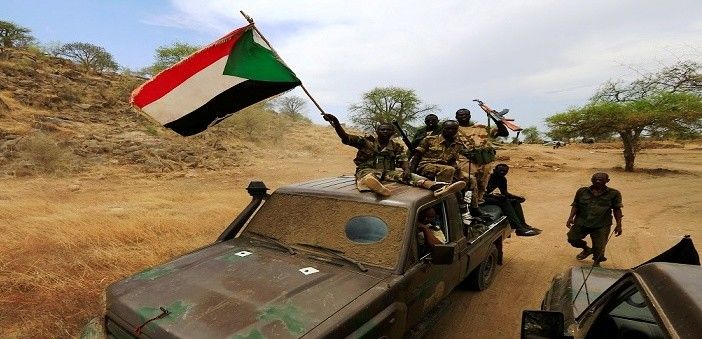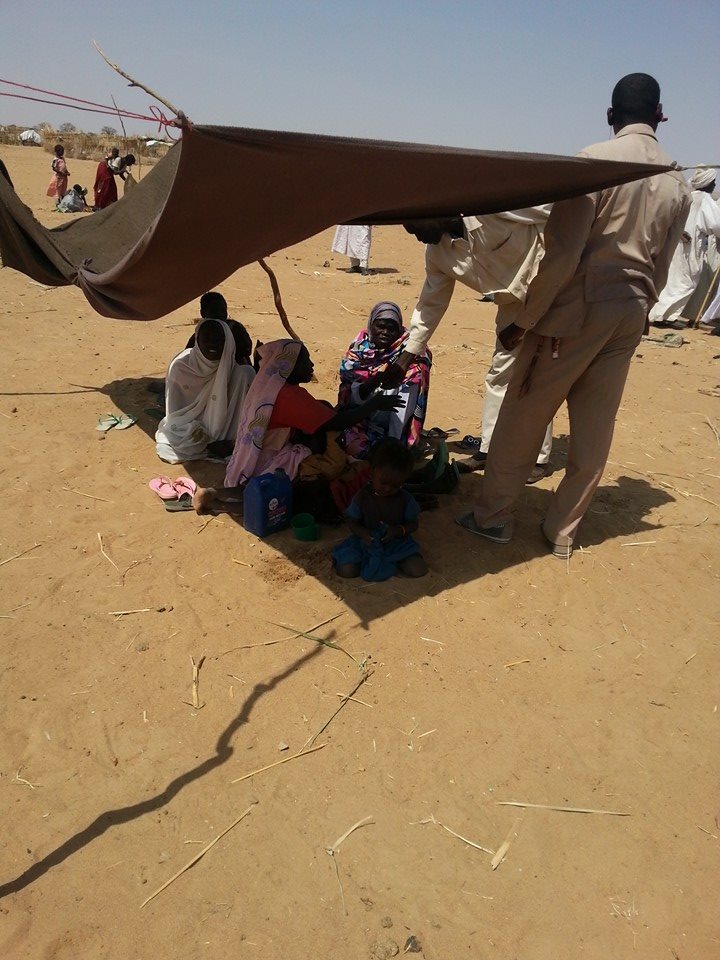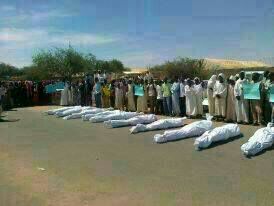This is the eleventh installment of a digest containing what I believe to be the most important stories reported by Radio Dabanga in the previous week. Radio Dabanga continues to be by far our most important and reliable source of information about what is occurring in Darfur, and provides a great deal more than the UN/African Union Mission in Darfur (UNAMID), the UN Office for the Coordination of Humanitarian Affairs (OCHA), and the largely worthless quarterly reports of the UN Secretary-General.
OVERVIEW
In the further wake of Sudan’s electoral travesty, this week has again been particularly dense with detailed news about violence and the deteriorating humanitarian situation in Darfur. Per usual, there are ten primary stories, with related stories in subsidiary positions in the text. Of particular note are the reports on growing water shortages in several locations, a problem that has threatened Darfur for years, given the high concentration of populations in areas without adequate aquifers. Also of note is the explosive and highly dangerous rise in tensions between the Rizeigat and Ma’aliya (Arab) tribes in South Darfur. Assaults on civilians by the Rapid Support Forces, Khartoum’s “militia of choice,” continue throughout Darfur but are concentrated in East Jebel Marra. Indiscriminate aerial bombardment of civilians and sexual assaults on girls and women continue to be standard weapons of war.
I continue to emphasize in this digest that what is now called “Central Darfur” was formerly part of West Darfur (and to a lesser extent South Darfur). The further division of Darfur by the National Islamic Front/National Congress Party (NIF/NCP) regime in 2012 was arbitrary and entirely politically motivated; it has also worked to encourage geographical confusion (the western part of “Central Darfur,” for example, borders eastern Chad). Similarly, “East Darfur” was also created arbitrarily in 2012 from parts of South Darfur. Geographically, it designates the southeastern region of Darfur.
This emphasis on geographical clarification derives from the fact that while North Darfur and eastern Jebel Marra continue to be the site of the greatest violence in Darfur, reports from West Darfur (including what is now “Central Darfur”) as well as South Darfur (including what is now “East Darfur”) are increasing alarmingly.
The UN has said no more about Khartoum’s refusal to allow the medical flight evacuation (medevac) of a badly injured UNAMID peacekeeper in West Darfur (the Ethiopian soldier later died of his injuries, perhaps for lack of access to a trauma center because of the denied medevac). Such denial is not without precedent (see Digest No.10 | http://wp.me/p45rOG-1Gt ).
Together these incidents, along with Khartoum’s complicity in multiple deadly attacks on UNAMID, provide the context for a decision that is imminent in the negotiations between the UN, the African Union, and the Khartoum regime about the re-authorization of UNAMID; current authorization expires in less than two months (June 30, 2015). What we are seeing is Khartoum’s effort to create significant “facts on the ground.”
Even as the NIF/NCP regime is pushing for UNAMID’s “exit,” there are growing signs of civil unrest, especially in universities in several locations around the country. Darfuri students—and as indicated below even families of Darfuri students—are being detained, threatened, and beaten because of their prominence in the strengthening civil society movement that clearly will not end without a change in the regime. But it is not simply Darfuris: people from all over Sudan are growing increasingly restive, angry, and demanding of change. This is what accounts for the astonishing figure that Radio Dabanga provides in the first dispatch that appears here: 66 print runs of Sudanese newspapers have been confiscated in the past year alone. Print journalists—all broadcast resources in Sudan are completely under the control of the regime—know that there are many “red lines” they must cross, but even a tentative testing of these restrictions provokes action by security forces.
Another Radio Dabanga dispatch notes the tremendous costs the international community incurs responding to the needs of a country that has been ravaged by the regime, an economy that has been plundered by the regime, and an agricultural sector that the regime has allowed to collapse—obliging imports that cannot be paid for because the regime has no Forex with which to pay. There have been acute shortages of imported wheat—which is made into flour and then bread, a food staple for most people in Sudan. This shortage of imported wheat is the reason we repeatedly see reports of bread lines and bread shortages all over the country, even in the Khartoum/Omdurman areas.
All dispatches have again been edited to some degree for length; any editorial comments on my part appear italicized in [brackets] and in blue; all emphases within the cited texts have been added.
Darfur: Radio Dabanga Digest, Number 1 | http://wp.me/p45rOG-1CD
Darfur: Radio Dabanga Digest, Number 2 | http://wp.me/p45rOG-1De
Darfur: Radio Dabanga Digest, Number 3 | http://wp.me/p45rOG-1Dt
Darfur: Radio Dabanga Digest, Number 4 | http://wp.me/p45rOG-1Ei
Darfur: Radio Dabanga Digest, Number 5 | http://wp.me/p45rOG-1EL
Darfur: Radio Dabanga Digest, Number 6 | http://wp.me/p45rOG-1Fp
Darfur: Radio Dabanga Digest, Number 7 | http://wp.me/p45rOG-1FL
Darfur: Radio Dabanga Digest, Number 8 | http://sudanreeves.org/2015/04/19/6452/
Darfur: Radio Dabanga Digest, Number 9 | http://wp.me/p45rOG-1Gi
Darfur: Radio Dabanga Digest, Number 10 | http://wp.me/p45rOG-1Gt
Darfur: Radio Dabanga Digest, Number 11 | —and below
Eric Reeves, 10 May 2015
***************
• 66 print-runs confiscated in one year: Sudanese journalists
May 3, 2015 | Khartoum
Between 3 May 2014 and 2 May 2015, 66 print-runs of Sudanese newspaper were confiscated by the National Intelligence and Security Service (NISS), the Sudanese Journalists’ Association for Human Rights (JAHR) reported today. A record number of confiscations took place on 16 February this year, when the freshly printed copies of 14 newspapers were seized on one day. The NISS did not provide any reason. In its annual report released today (Sunday), coinciding with the World Press Freedom Day, JAHR documented 13 physical assaults on journalists. Nine women journalists were abused by policemen, and 20 by security officers. Twelve women journalists were questioned by prosecutors of the National Press and Publications Council in Khartoum and Wad Madani, capital of El Gezira state, because of their alleged “crimes against the state of Sudan,” and eighteen were abused by representatives of various state institutions.
In its Freedom of the Press 2015 report, launched in Washington on 29 April, the USA-based Freedom House describes the situation of the media in Sudan as “not free.” The country rates 176, together with Gambia and Venezuela, of the 199 countries listed in the report’s Global Rankings.
The purpose of confiscating print runs is to exhaust the newspapers financially, the editor-in-chief of El Jareeda newspaper commented to Radio Dabanga in July 2014. “It is in fact a direct and methodical liquidation, meant to kill the independent press.”
[The claim by former Obama administration special envoy for Sudan Princeton Lyman—“we want to see the regime carrying out reform via constitutional democratic measures”—obviously took no account of the essential fact that a free press is key to processes of reform and democratization. This was borne out in dramatic faction by last month’s electoral parody, which saw President Omar al-Bashir re-elected with 94 percent of “the vote,” 26 years after he came to power by military cou—and holding no subsequent elections with the slightest integrity. Reporters Without Borders, in its most recent assessment, ranks Sudan as 174th out of 180 countries surveyed in its 2015 World Press Freedom Index.]
• “Darfuri students not able to continue studies in Sudan’s capital”
May 4, 2015 | Khartoum
The violent campaign by militant student members of the Sudanese ruling party against Darfuri students in various universities in Khartoum has raised broad concern. The students have been threatened after the head of the National Islamist Students Movement (NISM) was killed during clashes at Sharg El Nil University in Khartoum last Wednesday. A Darfuri student told Radio Dabanga the next day that about 150 militant students of the National Congress Party stormed the Sharg El Nil campus on Wednesday. Backed by university guards, they molested members of the Darfur Students Association who were having a meeting. “They attacked us with metal bars, crutches, and machetes. Dozens of students were wounded, seven of them seriously. One of the assailants, Mohamed Awad El Karim, Secretary-General of the National Islamist Students Movement, was killed.” The Islamist Students Movement is the student wing of the NCP.
Demonstrations at El Azhari University in Khartoum North against the clashes on Wednesday were dispersed with tear gas.
Speaking to Radio Dabanga from Khartoum, a Darfuri student told about the difficult conditions he and his fellow students are currently living in. “The hate campaign against us is widening. Islamist students are threatening to get rid of us, and many Darfuri students are living in constant fear and anxiety.” He added that the Darfuri students who sustained injuries during the attacks last week did not dare to go to a hospital for treatment. “As they fear the intervention of security agents stationed at the hospitals, they are being treated in the dormitories, or when they are lucky at their homes. There not many options left for us. It is extremely difficult to continue studying in these circumstances. Most probably, we will have to quit our studies officially…”
The Student Secretariat of the National Umma Party also condemned the “systematic violence against Darfuri students.” In a statement on Sunday, it holds the students of the NCP responsible for instigating the “brutal campaign,” and criticised the “silence of the universities’ managements” concerning the attacks…
Human rights lawyer Saleh Mahmoud warned of an escalation of the “systematically targeting by the NISS of Darfuri students.” The lawyer told Radio Dabanga that the “expansion of this phenomenon is now threatening the social stability in the country, as the violence instigated by the regime will generate counter-attacks.” He holds the government accountable for the violence.
The secretary-general of the Sudan People’s Liberation Movement, Yasir Arman, accused the NCP of violently attempting to silence the “winds of change” among the Sudanese after the rigged elections. “The Khartoum regime is targeting the Darfuri students first to break their will, and with this the other students will be silenced,” he told Radio Dabanga, “and with them the entire population. The issue is not an internal students matter, but concerns the whole country.”
He said that the violence against the students has entered a new phase, similar to the military campaign of the paramilitary Rapid Support Forces, commanded by the NISS, against civilians in Darfur and South Kordofan.
[Related stories appear at the end of this dispatch]
• Sudan Humanitarian Response Plan requires $1 billion this year
May 5, 2015 | Khartoum
With 5.4 million people, some 15 percent of the Sudanese population, estimated to require some form of humanitarian assistance, the projected humanitarian needs in the country remain high. Humanitarian organisations in Sudan seek more than $1 billion this year to fund projects, delivered by 112 partners to meet the needs of these people. The humanitarian community in Sudan continues to respond to massive humanitarian needs, both in terms of funding required, and the number of people requiring assistance, UN Resident and Humanitarian Coordinator a.i. in Sudan, El Mostafa Benlamlih, stated at the launch of the Sudan 2015 Humanitarian Response Plan today.
Sudan is currently facing two major humanitarian crises simultaneously: Conflict-induced displacement, with a total of 3.1 million displaced people living away from their homes with inadequate or no access to basic services and livelihood opportunities, and food insecurity and malnutrition, which affects 4.2 million people across Sudan. Some 550,000 children in Sudan are suffering from Severe Acute Malnutrition.
[Given the immensely destructive potential of Severe Acute Malnutrition, this is a truly staggering figure, and speaks volumes about the Khartoum’s regime’s contempt for the well-being of the Sudanese people; the majority of these children will die. The UN’s Office for the Coordination of Humanitarian Affairs also indicates in its most recent report that Global Acute Malnutrition affects 2 million Sudanese.]
Life-saving assistance is a priority. “As conflicts continue unabated in and around Sudan, the number of displaced and new refugees is unfortunately expected to increase,” Benlamlih explained. “This demands our collective and unified response.” To address these humanitarian challenges, “partnerships among all stakeholders—national and international, state and non-state, donors and operational agencies—are crucial in ensuring people receive or can access the aid they need to survive and live in dignity.”
[Despite the critical need for international nongovernmental humanitarian relief organizations, Khartoum continues its unrelenting assault on and obstruction of these very organizations. They are expelled, workers are abused or attacked, assets belonging to the organizations are stripped in a range of ways, and critical supplies being brought into Sudan are frequently delayed without justification. Visas for humanitarian workers and assessment experts are frequently delayed or denied. Publicly regime officials refer to these essential relief organizations as “spies,” as “conspirators doing the work of Zionists,” of “failing to do their jobs,” of using their work in Sudan as an inappropriate and selfish means of fund-raising—and the list goes on. The Khartoum regime cannot feed its people, cannot provide primary medical care for a substantial percentage of the population, and has done nothing to improve water quality and accessibility—all tasks it is willing to leave to the very organizations it abuses and excoriates.]
Developed in consultation with the Sudanese government, the UN and Partners’ 2015 Sudan Humanitarian Response Plan is a tool used to map where humanitarian projects can best respond to people’s priority needs in the country, and to allocate funding accordingly.
[That the UN is compelled to develop its plans for humanitarian relief not on the basis of need but in terms acceptable to Khartoum—which include denying humanitarian access to many regions of Darfur as well as rebel-controlled areas of Blue Nile and South Kordofan—should be deeply troubling, given the high cost of the operations. The UN has lost the ability to push back with any effectiveness on even the regime’s most outrageous stipulations about the conditions for aid. To speak about the 2015 Sudan Humanitarian Response Plan as a tool for mapping “where humanitarian projects can best respond to people’s priority needs in the country, and to allocate funding accordingly” is shamefully disingenuous in light of the continuing humanitarian blockades in South Kordofan and Blue Nile, and the denial of aid to much of Darfur, especially Jebel Marra.]
Women collecting remaining food in their burned-out village in Darfur
• Water shortage in South Darfur city remains unsolved
May 6, 2015 | Nyala
Districts in Nyala, the capital city of South Darfur, are witnessing a crisis of drinking water, as a result of the disruption of the water stations that supply the tanks. Some districts have faced a shortage in water for months. The price for water is rising, a person living in El Jebel district in Nyala said. “We bring water on animals’ backs from Wadi Berle now… I hope that the authorities can resolve the water problem in Nyala, which is repeated every year.” He told Radio Dabanga that the government authorities do not provide any radical solutions for the recurring water shortage. “The growing need for water in Nyala is far more than the water sources can provide.”
[Water shortages have led to the drinking of contaminated water; this explains this outbreak of schistosomiasis in various localities in South Darfur, where acute water shortages have been reported.]
An official from a water corporation in Nyala explained that the electric power disruption was the main reason for the non-flow of water to the city. He pointed out that the growing need of the city is far more than the available water sources can provide. He revealed that Nyala depends on 18 wells, along with Wadi Berle.
Maintaining, servicing, and replacing water pumping equipment as necessary has become extremely difficult in the current environment
Meanwhile, the more than 80,000 residents of El Salam camp for the displaced, south of Nyala, suffer from an acute drinking water crisis, too. A camp leader told Radio Dabanga that the first water engines in the camp broke down five months ago, and that about 20 have stopped working ever since.
[These problems have been all too foreseeable. Indeed, in 2007 the humanitarian organization Tearfund conducted two detailed studies of the water supplies and environmental conditions in various locations throughout Darfur; “Darfur: Relief in a Vulnerable Environment” and its conclusions of more than seven years ago are all too telling today (from the Executive Summary):
Environmental degradation in Darfur (all emphases added—ER)
- Environmental resources are crucial to people’s lives, livelihoods and cultural identity in Darfur. One of the most important livelihood assets in a subsistence economy are the environmental resources.
- Darfur’s environment is particularly resource poor and suffers from very high natural variability and unpredictability.
- Over the last three decades demands have increased as the population has risen, and the resource base has been eroded by unmanaged intensification of farming, grazing and deforestation. Over the same period the native administration system has been eroded, rainfall has been low, populations have migrated to more fertile areas, and political instability and violence has increased.
- The environment is a crucial part of the current conflict. Environmental resources are being fought over and are being destroyed as a feature of the violence. The drivers for conflict over environmental resources have been significantly exacerbated by the current crisis. Actions include the destruction of crops and water points, the restriction of livestock migration causing local overgrazing, and the destruction of trees and rangeland.
- Traditional environmental management systems have collapsed in the context of conflict.
- A high level of deforestation is taking place in the context of conflict.
- The current crisis has caused unprecedented concentrations of demand for water, forest products, grazing and other environmental resources. This has caused significant localised depletion of these resources.
- Protection provided to IDPs is significantly worsened by the depletion of natural resources, as resource collection becomes more difficult.
- The humanitarian programme is heavily dependent on environmental resources. The depletion of resources already limits the delivery of the relief programme.
- Livelihoods that are thriving in the context of the crisis, such as brick-making and charcoal-making, are placing unsustainable demands on natural resources. These are important livelihoods in the IDP camps.
- The heavy environmental impact of prolonged displacement is degrading some of Darfur’s most valuable agricultural land. Many IDP camps are built around agricultural market towns, which means that land degradation affects prime farmland, undermining livelihoods for both the displaced and the host population, affecting the crisis as well as the future recovery period.
- The demands for forestry will be considerable at the time of reconstruction. With 2 million people displaced, and a single family compound requiring 30–40 mature trees to be rebuilt, the demand for reconstruction if all IDPs returned would be 12–16 million trees.
- Environment as a cross-cutting theme is not adequately integrated in the relief programme and suffers from a lack of technically skilled personnel. The omission to undertake monitoring of groundwater depletion in camps in an arid area over a three year period is a significant one. [end]
All the problems indicated here have worsened significantly in the years following the report; see below.]
Pumps stall, water crisis North Darfur camp
May 8, 2015 | ZamZam Camp
Reports of shortages of drinking water in the Darfur region continue, as displaced people living in Zamzam camp, near El Fasher, have renewed their complaints about the water crisis in the camp. They said that there are no signs indicating that the problem will be resolved soon. According to an activist in the North Darfur camp, the water crisis has worsened after more than seventeen pumps have stalled in the camp, which accommodates a large displaced population. “People spend most of their days in long queues in order to obtain water. Yet, they don’t get access to sufficient amounts.”
[This may be the great humanitarian crisis in Darfur in the near term: inadequate water for displaced persons in camps that long ago reached the maximum population that could be sustained with local water supplies. Reports such as this and the following have been noticeably increasing.]
Water shortages are increasingly common and increasingly threatening
Thirst in South Darfur’s El Salam camp
May 4, 2015 | El Salam Camp / Nyala
The more than 80,000 residents of El Salam camp for the displaced, south of Nyala, capital of South Darfur, are suffering from an acute drinking water crisis. Sheikh Mahjoub Adam Tabaldiya told Radio Dabanga that the displaced are “actually short of drinking water since five months, when the first water engines broke down. During the past five months, 20 pumps stopped working. The last one, at Block 5, used by far too many people in the end, broke down nearly one month ago.” Tabaldiya pointed out that the displaced now “have to walk long distances to fetch water, as the price of drinking water sold commercially is rising fast.”
[Khartoum’s failure to ensure the repair of these “water engines” is a measure of how little concern the regime has for the fate of displaced persons in Darfur, who are overwhelmingly from non-Arab/African tribal groups.]
“More schistosomiasis cases in South Darfur”: official
May 10, 2015 | Nyala
Some localities in South Darfur have witnessed a rise in schistosomiasis cases, according to state officials. The director of the administration that fights against malaria and schistosomiasis, Jaffar Abdallah, has acknowledged that there is a rise in the prevalence of the disease in some southern localities. It is a parasitic disease caused by trematode flatworms. Abdallah claimed that the prevalence has amounted to “42%, according to surveys in 2012. “In Shalal Goz El Radoom, it amounted to 92%. Furthermore, 55% in Um Janah and 8% in Um Zaifah in East Jebel Marra.” He announced that the start of the campaign against the risks of schistosomiasis and intestinal worms will “last for a month” and target fifteen of all localities, being Kutum, Ed El Fursan, Tullus, Buram and El Mardoom.
[Schistosomiasis is a serious disease, especially among children; it spreads my means of contaminated water supplies.]
The schistosoma parasite
A victim of acute schistosomiasis
• El Fasher Grand Market in North Darfur closed since two days
May 7, 2015 | El Fasher
The traders at the Grand Market of El Fasher embarked on a strike on Tuesday. Speaking to Radio Dabanga from the North Darfuri capital, a merchant said that they did not open their shops and stalls since Tuesday, in protest against repeated burglaries by militiamen at night. “Only the vegetables section is open.” He explained that the latest theft occurred on Monday, when “an armed group emptied two stores, and loaded the goods on their Land Cruisers.”
The normally very busy Grand Market of El Fasher on May 4
[The broader collapse of markets across Darfur have had a devastating effect on the economy for all. Everywhere, the absence of security exacerbates this problem.]
• Two die in air raids on Darfur’s East Jebel Marra
May 7, 2015 | East Jebel Marra
A mother and her child were killed in aerial bombardment on East Jebel Marra on Wednesday. A resident of the area told Radio Dabanga that an Antonov began bombing the area north of Fanga at 11am. “One of the eight bombs dropped led to the death of Hasina Omar Ishag and her baby daughter Darelnaeem Saleh. Eight cows and four donkeys were also killed. Pastures in the area were set aflame,” he said. He added that the Sudanese fighter jets continued circling above the area until sunset.
[As women, children, the elderly and infirm are relentlessly targeted for bombing attacks, the silence or muted condemnations from the international community make clear that “the responsibility to protect” no longer exists even in verbal form. Promulgated officially by the entire international community in the UN Summit Outcome Document of September 2005 (¶138 and ¶139)], the phrase has joined “never again!” as evidence of a gross and shameful hypocrisy on the part of the international community.]
Some of the advanced military aircraft used against civilians in Darfur, South Kordofan, and Blue Nile; these are in addition to the high-flying, inaccurate, “retrofitted” Antonov cargo planes, serving as “bombers” to terrorize and randomly kill civilians and civilian targets
Aerial bombardment in Darfur’s East Jebel Marra
May 8, 2015 | Kaguro
An aerial bombardment hit Kaguro area in East Jebel Marra on Thursday, killing a number of livestock. The bombing caused panic among the residents of Kaguro; however, no losses of life were reported. A witness told Radio Dabanga that at 1p, and Antonov plane of the Sudanese Air Force dropped three bombs in the area. He said that more than 25 sheep and goats were killed. “The plane kept flying over the area from 6am to 1pm, before it dropped the bombs.”
Livestock are particularly vulnerable to aerial bombardment, frequently dying of minor wounds or even from shock.
• Displaced girl raped, “two men arrested” in West Darfur
May 8, 2015 | Sirba
A displaced girl of twelve years old was raped by five men in Sirba locality, West Darfur, on Wednesday. She is in the hospital, while the police have taken two people into custody. The coordinator of the camps for displaced people in Sirba reported the incident, which happened east of Sirba, to Radio Dabanga. He said that the militiamen wore military uniforms and that they raped the victim near Abu El Rish, in one of the valleys close to a camp. “People found the girl bleeding on the ground in one of the valleys. She was taken to the hospital in Sirba, and then to El Geneina, for treatment.” He added that the incident was reported to the police, and claimed that they managed to arrest two of the perpetrators.
[There is nothing in the history of genocide in Darfur to suggest that the perpetrators of this horrific crime will be prosecuted—nor even that those arrested were really among the five rapists. Militiamen sexually assaulting women and girls in Darfur do so with complete impunity.]
Women live in constant fear
Girl raped near North Darfur camp
May 6, 2015 | Shangil Tobaya
Militia members raped an internally displaced girl from Shaddad camp in North Darfur, near Shangil Tobaya, on Monday. The members of a pro-government militia attacked four displaced women who were collecting straw and firewood, just 2km west of the camp. They seized one of them, a 16-year-old girl, and raped her for several hours. The three other women managed to escape from the men, a witness explained to Radio Dabanga. After four hours, the militiamen left the girl in poor condition. The victim was brought to a hospital in El Fasher for treatment.
[Unfathomable cruelty]
The targets of sexual assault
Two women raped at militia base in Darfur’s East Jebel Marra
May 7, 2015 | Eastern Jebel Marra
Two young women were gang-raped by militiamen at the Rapid Support Forces (RSF) base near Deribat in East Jebel Marra on Monday. A relative of the victims reported to Radio Dabanga that elements of the government militia ambushed the women at 11 am, when they were on their way to fetch water from a well in Kuro, north of Deribat. “They took to their base in the area, and alternately raped them for a full day,” she said. “They were only released on Tuesday morning.”
[Sexual violence against women and girls has remained at epidemic proportions for years.]
Hoping, in vain, for protection
• Sudan’s RSF kills, pillages in East Jebel Marra villages
May 8, 2015 | East Jebel Marra
Three people were killed by a force of Sudan’s paramilitary troops on Friday, and others were abducted, when the force pillaged a village in East Jebel Marra. Other villages were attacked on Thursday. Sources in the area claimed the troops were moving from South Darfur. Rapid Support Forces (RSF) in “about 200 heavily armed vehicles” entered Dobo El Madrasa as they came from the direction of Malam in Alwehda locality, South Darfur. A witness reported that the militiamen immediately opened fire at the people who fled the scene. Three were killed on the spot: Kaltum Ibrahim Saleh (25 years old), Bahreldin Omar Yousif (35 years), and Abaker Harun Yahya (40 years). At least seven villagers were injured when beaten by the RSF troops.
Villagers fleeing from their homes in the Kenjara area of North Darfur
They took many others to an unknown destination, including girls and boys, the witness told Radio Dabanga. A relative of one of the kidnapped boys explained that from his family, “Ismail Musa Ahmed (11 years), Ibrahim Hamid Adam (13), Abdellatif Saleh Yahya (13), Shogar Harun (14), and Mohamed Abdallah Omar (19) were taken from Wadi Karo, north of Dobo El Madrasa.” “We don’t know exactly how many people were injured or captured,” the witness said, “because all the people have fled to the surrounding valleys.” The militiamen also robbed money, livestock and other belongings from the residents during the raid.
A militia pillaged Dali, Dawa, and Masalit villages in East Jebel Marra on Thursday. People in the area sustained injuries, of whom five seriously. “They beat the people and stole their money, and about 250 heads of cattle,” a source in the area reported to Radio Dabanga. “Mariam Omar Dako, Musa Isa, Ibrahim Ismail, Adam Ishag, and Ibrahim Mohamed were seriously wounded by the militiamen.” He said that the militiamen drove in five vehicles, mounted with a machine gun, and others rode on camels when they attacked Dali, Dawi and Masalit. “They came from the direction of Malam in South Darfur. The militia also attacked Um Budja, Sharafa, and Arashu, assaulted the residents, and took their money.”
Burned village in Kenjara area, North Darfur—one of many
Five dead, four injured in Darfur attacks
May 5, 2015 | Korma / Bindisi
Four people were killed, and four others wounded in an attack on a commercial convoy in North Darfur on Saturday. A villager was shot dead by militiamen in Central Darfur’s Bindisi on Monday. One of the passengers reported to Radio Dabanga that militiamen riding in Land Cruisers mounted with Dushka machineguns opened fire on a convoy of four passenger lorries near Korma, on El Fasher-Kabkabiya road. “Four passengers were fatally hit, and four others were injured. The militiamen then robbed all of us, destroyed one vehicle, and left with the other three…”
On Monday, militiamen attacked Abakar Ibrahim Abakar inside his home in the area of Kalam Basanan, west of Bindisi town. A relative of the victim told Radio Dabanga that a group of gunmen stormed the house of Abakar, and shot him. “He died of his wounds upon his arrival at Bindisi hospital.”
[Violence against civilians continues the escalation evident over the past several years; the attacks or not only more frequent, but more frequently deadly.
Two men killed by militiamen in South Darfur
May 8, 2015 | Niteaga / Bielel / Jebel Marra
Militia members shot dead two people and seriously wounded another in two separate incidents in Niteaga and Bielel localities in South Darfur on Wednesday. The first incident occurred west of Niteaga, where pro-government militiamen opened fire on Mohamed Ismail. They shot him dead on the spot and stole his cattle. The second incident occurred at an area called Mirair in Bielel locality, where militiamen attacked a resident inside his house and shot him and his son. The father died of his wounds.
On Wednesday, herders assaulted the inhabitants of three villages in East Jebel Marra, along with robbing their money, belongings, and livestock. A witness told Radio Dabanga that at 7 pm the group of herders of the Abbala tribe, “who were armed by the government,” attacked the villages of Hemeda, Dalma, and Shurfa. “They were riding on camels and wore military uniforms.” He reported that the residents left the villages to Shangil Tobaya.
Merely targets in the eyes of the Rapid Response Militia forces
Villager killed, two injured in North Darfur armed robbery
May 3, 2015 | Alliet Jar el-Nabi | El Fasher
A villager was killed and two others were wounded in an armed robbery in Ailliet locality, North Darfur, on Saturday. In North Darfur’s capital of El Fasher, an engineer was robbed of his vehicle on Friday. Speaking to Radio Dabanga, a resident of Um Labana village, located between Ghibeish and Alliet Jarelnabi, reported that a group of nine gunmen in a Land Cruiser mounted with a Dushka machinegun stormed the village on Saturday evening. “They fired into the air. Stray bullets hit one of the villagers fatally. Two others were injured.”
Elements of Khartoum’s Rapid Response Force militia
Displaced molested by militiamen in West Darfur’s Sirba
May 3, 2015 | Sirba Locality
A group of militiamen beat up five residents of the Ban Jadeed camp for the displaced in Sirba locality on Wednesday. A camp elder told Radio Dabanga that government-backed militiamen ambushed three displaced women not far from the camp. When they resisted the attackers, two men from the camp intervened. “Maimouna Hassan, Hawa Ibrahim, Fatima Adam, Hammad Adam, and Mohammed Adam were subjected to severe beating and whipping. All five had to be treated at Sirba hospital…”
One killed in militia attack on North Darfur village
May 10, 2014 | North Darfur
A militia attacked a village in North Darfur on Thursday, and is reportedly responsible for the death of a merchant. Another person was seriously wounded when the militia members opened fire on them. Nine militiamen entered Um Liona (or Leona) in a Land Cruiser with a machine gun mounted on top, a witness reported. They opened fire on the merchant Suleiman Bushra and shot him dead on the spot. “They robbed his money and other belongings. One other person was wounded, Kinein Adam, but the gunmen fled and got away.”
Villagers robbed of their livestock in North Darfur
May 5, 2015 | Tawila / Birkat Seira
180 cows and more than 20 goats were stolen in two separate incidents in North Darfur during the past days. Speaking to Radio Dabanga, Omda Mukhtar Bosh, coordinator of the Tawila camps for the displaced, reported that militiamen in eight Land Cruisers and others riding camels launched an attack on the area of Beer Kolo, 15 km west of Tawila town, early on Sunday morning. The villagers in the area were taking out their livestock for grazing. The attackers took 180 head of cattle, and left into the direction of Um Jalbakh and Kabkabiya.” On Monday morning, a group of gunmen raided Birkat Seira in Saraf Umra locality, and stole more than 20 goats at gunpoint. One of the victims told Radio Dabanga that the animals were used by parents to provide milk for their children.
Abductions for ransom continue in Darfur
May 6, 2015 | Nierteti (formerly West Darfur] / Saraf Umra, North Darfur
A ransom has been demanded for the three men who were abducted by militiamen in Nierteti, [formerly West] Darfur, last Thursday. Two merchants were abducted in North Darfur on Monday. A relative of one of the three abductees informed Radio Dabanga that pro-government militiamen called their families on Monday, and demanded the payment of SDG 80,000 ($13,309) for their release. Abdel Nasir Ali Suleiman, Elias Ahmed, and Mohamed Mohamed Ahmed are currently held between Khor Ramla and Diko, west of Nierteti town. They were kidnapped at gunpoint by militiamen on camels and horses, on the way to Nierteti’s weekly market while coming from Omi village on Thursday.
In Saraf Umra locality, North Darfur, pro-government militiamen abducted a merchant and a veterinarian from inside a market, in broad daylight, and took him to an unknown destination on Monday. A witness explained that about eight militiamen in a Land Cruiser raided a veterinary shop, and fired shots into the air, before abducting the shop owner, and another merchant, at gunpoint.
[The dramatic increase in abductions for ransom, extortion schemes of various sorts, land appropriation, and other means of asset-stripping have replaced the plunder taken from villages burned in the earlier years of the genocide.]
Newly displaced persons in Tawila, North Darfur
• Tension between [formerly South] Darfur tribes “about to explode“
May 8, 2015 | El Ferdous / Adila
Fighters belonging to the Rizeigat and Ma’aliya tribes are gathering in large crowds in [formerly South] Darfur, according to eyewitness reports. It is expected that clashes between the tribal fighters could erupt at any moment. The state therefore deployed a number of troops to the areas to contain the situation. The Rizeigat tribesmen are gathering in two areas in El Ferdous locality: El Jalabi and Donki El Fadul, an eyewitness reported to Radio Dabanga. Large crowds of Ma’aliya fighters are spotted in Adila and Abu Karinka localities. “The first gathering started four days ago,” the witness said on Friday. He expects the tribes to clash soon, allegedly resulting in many casualties.
The Governor of East Darfur, Col. El Tayeb Abdelkarim Ahmed, admitted to the radio station that large crowds of tribesmen are present in the state. “We have taken measures to prevent fighting between the two sides. These include the deployment of a number of troops to the border strip between El Ferdous [where the Rizeigat have gathered] and Adila and Abu Karinka [where most Ma’aliya reside]….”
At least 16 people were killed and injured in renewed clashes between Rizeigat and Ma’aliya tribesmen in Abu Karinka locality on 29 April, against the backdrop of mutual livestock rustling. Since then, the state of East Darfur has demanded the return of military equipment that gunmen seized from the Central Reserve Police in Abu Karinka. The paramilitary Central Reserve Police, known as “Abu Tira,” has enlisted many Rizeigat among its troops.
[Continuing inter-Arab tribal fighting makes Darfur an even more broadly threatening and insecure region. Khartoum’s powerlessness to prevent further such violence is an alarming sign of what the Darfur of the future will look like. The Central Reserve Police (Abu Tira) have been responsible for most of the violence against civilians until the ascendency of the Rapid Response Forces.]
East Darfur authorities order tribesmen to return arms
May 3, 2015 | Abu Karinka
The governor of East Darfur [formerly South] Darfur has given gunmen 24 hours to return the military equipment they seized from the Central Reserve Police in Abu Karinka locality last Wednesday. The deadline would end on Saturday, [formerly South] Darfur governor Col. El Tayeb Abdelkarim told reporters on Friday. He demanded the return of two Land Cruisers, two Dushka machineguns, four other machine guns, and seven rocket-propelled grenades (RPGs). On Wednesday, fighting erupted between Rizeigat and Ma’aliya tribesmen in the area of Wad El Bilal, west of Abu Karinka town, against the backdrop of mutual livestock rustling. Both parties were heavily armed, and made use of Land Cruisers mounted with machineguns in the fighting. The paramilitary Central Reserve Police, known as “Abu Tira,” has enlisted many Rizeigat among its troops.
[A source in Abu Karinka] confirmed that the situation in the area is very tense, and warned for the possibility of renewed clashes in the area, between the authorities and the militants, in case the equipment is not returned.
• More on the arrest and abuse of Darfuri student in Khartoum and universities in other cities:
Sudan security detains more Darfuri students in Khartoum
May 7, 2015 | Khartoum
The detention campaign by the Sudanese security apparatus against Darfuri students in the Sudanese capital is still continuing. At least 12 more Darfuri students were held in Khartoum on Tuesday and Wednesday. “Mohamed Adam Boko was detained in front of the gate of Bahri University on Wednesday,” a student from Darfur reported to Radio Dabanga. “Yet most of the students were held inside their homes.”
He said that many Darfuri students fear they may be charged with killing the head of the National Islamist Students Movement, the student wing of the ruling National Congress Party (NCP), last week, though authorities in Khartoum announced that the perpetrators have been arrested. Dozens of students from Darfur were detained after the head of the National Islamist Students Movement, the student wing of the ruling party, was killed in clashes at Sharg El Nil College on 29 April. About 150 militant NCP students, backed by university guards, reportedly attacked members of the Darfur Students Association who were having a meeting at the campus. Seven Darfuri students were seriously wounded. The campus was raided again on Thursday. At El Ahliya University in Omdurman, students were beaten and detained on Thursday too.
In a statement on Wednesday, the Sudanese Solidarity Committee against Racial Discrimination, abbreviated “Tasami” in Arabic, said that the current targeting of Darfuri students in the capital is part of a campaign against them that started much earlier. Pointing to the killing of dozens of students from Darfur in various parts of the country, and the eviction of Darfuri students from Khartoum dormitories last year, Tasami stated that the “current hate campaign is a continuation of the systematic exclusion targeting of certain ethnic groups and the implementation of ethnic cleansing policies.”
Victims of the Khartoum regime’s savage repression during the demonstrations of September 2013; security officers were given “shoot to kill orders,” according to Amnesty International.
The Solidarity Committee called on the Sudanese people to “form a broad solidarity coalition” to protect the Darfuri students “from oppression and racial discrimination.” Another opposition group, the New Democratic Forces Movement (HAG), has launched a “No to Racism” campaign against “the regime’s militia targeting of Darfuri students.” It called on all Sudanese to join the campaign, and continue their struggle until “the Khartoum regime is overthrown.”
Detained Sudanese Congress Party member “tortured”
May 3, 2015 | Kerima / Khartoum
One of the two members of the Sudanese Congress Party detained by security agents in Kerima, Northern state, on Thursday, has been released. He was reportedly tortured. The party’s spokesman, Bakri Yousef, told Radio Dabanga on Friday that members of the National Intelligence and Security Service (NISS) took Raafat Abdelghaffar and Ibrahim Hassan to the security office in Kerima following a public speech in the town in which the current political situation was criticised. “Abdelghaffar was released today. He had been beaten and tortured. Hassan is still being held.”
More Darfuri students, relatives detained in Sudan’s capital
May 5, 2015 | Khartoum
At least eleven Darfuri students were detained inside their homes in Khartoum on Monday. Speaking to Radio Dabanga, a student reported that agents of the National Intelligence and Security Service detained the mother of “Mohsen,” student at Sharg El Nil College, when they did not find him at home. “They took Fatima Mohamed Idris (50) with them instead, together with three relatives staying at her house in Umbadda, Omdurman, on Monday morning.
[A student in Khartoum] reported that Mohamed Abdallah Fangi, Abdelkarim Mohamed Yahya, and Gurashi Mohamed Shumo, students at Bahri University in Khartoum North, and Feisal Bakhit Abdelkarim of Sharg El Nil College were also held by security officers on Monday… “[The student] explained that no one knows the real number of students held by the security apparatus, “because of the mass detention campaign, and the difficulties Darfuri students have in contacting each other in these circumstances.”
The student further described the situation at the universities in Khartoum as “extremely difficult.” “Large numbers of armed student members of the National Islamist Students Movement [the student-wing of the ruling National Congress Party] and security officers are occupying all the universities in Khartoum, preventing us to pursue our studies.”
Sudan’s opposition takes action to protect students from Darfur
May 4, 2015 | Khartoum
The Sudanese opposition forces agreed to establish a committee for the protection of Darfuri students in Khartoum. Medical doctors will appoint three clinics in the capital where students from Darfur, injured during attacks by student members of the ruling party, can be treated. Members of the Darfur Bar Association, together with a number of other Sudanese lawyers, are ready to provide legal aid. At a meeting this (Monday) morning at the premises of the Sudanese Communist Party in Khartoum II, the opposition forces decided to act in order to protect Darfur students in the capital against the violent campaign, launched by student members of the National Congress Party, since last week.
The students have been threatened after the head of the National Islamist Students Movement was killed during clashes at Sharg El Nil University in Khartoum last week. Faroug Abu Eisa, chairman of the National Consensus Forces (NCF, a coalition of opposition parties) told Radio Dabanga today that NCP students have been urged to evict all Darfuri students from the dormitories in the Sudanese capital “by force or by fire.”
[Abu Eisa, as chairman of the National Consensus Forces, is very well-informed; his warning that NCP students have been “urged to evict all Darfuri students from the dormitories in the Sudanese capital ‘by force or by fire’” is ominous in the extreme.]
Last Wednesday, some 150 militant students of the National Congress Party (NCP) stormed the Sharg El Nil campus. Backed by university guards, they molested members of the Darfur Students Association who were having a meeting. “They attacked us with metal bars, crutches, and machetes. Dozens of students were wounded, seven of them seriously,” a Darfuri student reported to Radio Dabanga. “One of the assailants, Mohamed Awad El Karim, Secretary-General of the National Islamist Students Movement [NCP student wing], was killed.”
Yesterday, another student added that Darfuri students who sustained injuries during the attacks last week did not dare to go to a hospital for treatment. “As they fear the intervention of security agents, stationed at the hospitals, instead, they are being treated in the dormitories, or when they are lucky at their homes.”
Abu Eisa, who himself was released on 9 April after having been detained for four months, said that the participants of today’s meeting agreed to build “a bulwark of allied forces to protect the students and the people of Darfur against those ugly racist attacks.”
“This popular body will be broader than the country’s opposition forces, as it will include members of Sufi orders, popular committees, trade unions, and women and youth groups, university managers and lecturers, medical doctors, journalists, artists, and sportsmen.”
[However ambitious such an announcement may seem, it speaks to the fact that Sudanese political culture is reviving ever-more fully from its dormancy, and the two key features of this awakening are a commitment to regime change and a recognition of the importance of coalition-building.]
Relatives of Darfuri students “held in police custody” in Omdurman
May 7, 2015 | Khartoum
A number of family members of Darfuri students are reportedly being held in police custody in Omdurman. At least three Darfuri students were detained in front of Bahri University on Wednesday. [A witness said] a large number of Darfuri relatives of Sharg El Nil College students being held at the Dar El Salamat police station, south of the Libya market… He said that the next day, “factory worker Jamal Adam Saleh (20), labourer El Dom Hassan Taher (25), and Mona Zakariya, a university graduate, were held at the same house.
[The sheer number of arrests, and the varying background of those arrested, indicates just how seriously the regime is taking current unrest and demonstrations. The regime is confident that its security forces can deal with any crisis, using “shoot to kill” tactics if necessary. But more and more ordinary Sudanese are being affected by the political crackdown, the denial of press freedoms, the bread lines and shortages (along with cooking fuel shortages), and the broad sense that the economy is imploding. These are the people who must deal with the realities of inflation around 50 percent, the regime’s inability to import key commodities and goods for lack of foreign exchange currency, and very high levels of unemployment and under-employment. On top of all this, the regime has incurred the large bulk of Sudan’s US$48 in external debt.]
*******************************
“The victims [of the Holocaust] perished not only because of the killers, but also because of the apathy of the bystanders. What astonished us after the torment, after the tempest, was not that so many killers killed so many victims, but that so few cared about us at all.”
[Elie Wiesel, “Why were there so few?”]
